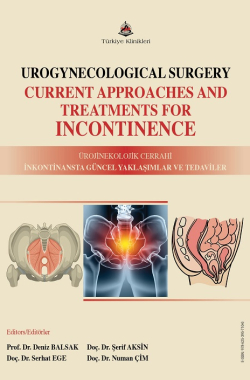VAGINAL OBLITERATIVE PROCEDURES
Serdar Aykut
Mardin Training and Research Hospital, Department of Gynecology and Obstetrics, Mardin, Türkiye
Aykut S. Vaginal Obliterative Procedures. In: Balsak D, Çim N, Ege S editors. Urogynecological Surgery Current Approaches and Treatments for Incontinence. 1st ed. Ankara: Türkiye Klinikleri; 2025. p.261-268.
ABSTRACT
Pelvic organ prolapse (POP) is one of the leading causes of urogynecological morbidity in women, with a markedly increased incidence particularly in the postmenopausal period. Its prevalence has been reported to reach 30–50% with advancing age, resulting in significant negative effects on quality of life. The etiology is multifactorial; advanced age, obesity, connective tissue weakness, history of vaginal delivery, multiparity, and conditions associated with chronic increases in intra-abdominal pressure (e.g., chronic cough, constipation) are considered major predisposing factors. Both conservative and surgical treatment options are available for POP; however, surgical intervention is usually preferred in advanced-stage cases. The choice of surgical procedure depends on several factors, including the patient’s age, systemic comorbidities, life expectancy, functional capacity, and, most importantly, sexual activity status. In this context, vaginal obliterative procedures represent a reliable and effective treatment modality, particularly in elderly, non–sexually active women with high comorbidity burdens. Obliterative surgeries are irreversible procedures based on partial or complete closure of the vaginal canal. The most frequently performed techniques are LeFort partial colpocleisis and posterior (total) colpocleisis, both of which are characterized by high anatomical and functional success rates, low surgical morbidity, minimal blood loss, short operative time, and rapid postoperative recovery. Moreover, because of their low mortality rates, these procedures can also be safely performed in elderly patients with elevated anesthetic risk and significant comorbidities. Although the permanent obliteration of the vaginal canal renders future sexual activity impossible—a major limitation—numerous studies have demonstrated that, with appropriate patient selection and indications, symptoms improve significantly, quality of life is substantially enhanced, and patient satisfaction remains high. Therefore, obliterative procedures are regarded as an effective and reliable surgical option in the management of POP, particularly among women who have completed their sexual life or have no future expectations of sexual activity.
Keywords: Pelvic organ prolapse; Colpocleisis; Urogenital surgical procedures
Kaynak Göster
Referanslar
- Abrar S, Mohsin R, Saleem H. Surgery for pelvic organ prolapse and stress urinary incontinence and female sexual functions: A quasi-experimental study. Pak J Med Sci. 2021;37(4):1099-1103. [Crossref] [PubMed] [PMC]
- Jokhio AH, Rizvi RM, MacArthur C. Prevalence of pelvic organ prolapse in women, associated factors and impact on quality of life in rural Pakistan: population-based study. BMC Womens Health. 2020;20(1):82. [Crossref] [PubMed] [PMC]
- Smith FJ, Holman CD, Moorin RE, Tsokos N. Lifetime risk of undergoing surgery for pelvic organ prolapse. Obstet Gynecol. 2010;116(5):1096-100. [Crossref] [PubMed]
- Buchsbaum GM, Lee TG. Vaginal obliterative procedures for pelvic organ prolapse: a systematic review. Obstet Gynecol Surv. 2017;72(3):175-183. [Crossref] [PubMed]
- Felder L, Heinzelmann-Schwarz V, Kavvadias T. How does colpocleisis for pelvic organ prolapse in older women affect quality of life, body image, and sexuality? A critical review of the literature. Womens Health (Lond). 2022;18:17455057221111067. [Crossref] [PubMed] [PMC]
- Raju R, Occhino JA, Linder BJ. LeFort partial colpocleisis: tips and technique. Int Urogynecol J. 2020;31(8):1697-1699. [Crossref] [PubMed]
- Abbasy S, Kenton K. Obliterative procedures for pelvic organ prolapse. Clin Obstet Gynecol. 2010;53(1):86-98. [Crossref] [PubMed]
- Wang X, Hu C, Chen Y, et al. LeFort colpocleisis for recurrent pelvic organ prolapse. Int Urogynecol J. 2020;31(2):381-384. [Crossref] [PubMed]
- Karram MM, Evans J. LeFort partial colpocleisis: key step-by-step technique and related obliterative procedures. OBG Manag. 2012;24(2):30-40. [PubMed]
- Lu M, Zeng W, Ju R, et al. Long-term outcomes after total colpocleisis with vaginal hysterectomy: a retrospective study. Female Pelvic Med Reconstr Surg. 2021;27(4):e510-e515. [Crossref] [PubMed] [PMC]
- Wang YT, Zhang K, Wang HF, Yang JF, Ying Y, Han JS. Long-term efficacy and patient satisfaction of Le Fort colpocleisis for the treatment of severe pelvic organ prolapse. Int Urogynecol J. 2021;32(4):887-893. [Crossref] [PubMed]
- Ertaş IE, Balıkoğlu M, Biler A. Le Fort colpocleisis: An evaluation of results and quality of life at intermediate-term follow-up. J Gynecol Obstet Hum Reprod. 2021;50(4):102069. [Crossref] [PubMed]
- Winkelman WD, Haviland MJ, Elkadry EA. Long-term pelvic floor symptoms, recurrence, satisfaction, and regret following colpocleisis. Female Pelvic Med Reconstr Surg. 2020;26(9):558-562. [Crossref] [PubMed]
- Dur R, Yalçınkaya Yılmaz A, Ahat B, Kanat Pektaş M. Vaginal hysterectomy during total colpocleisis: a single-center experience. Cureus. 2024;16(3):e56574. [Crossref] [PubMed] [PMC]
- Simms L, Maheshwari D, Harmanli O, Rastegar V, Diaz N, Jones K. Perioperative outcomes of colpocleisis at a single institution: a retrospective cohort study. Urogynecology. 2023;29(3):149-152. [Crossref] [PubMed]
- Kinci MF, Sezgin B, Arslaner MO, Gökbel DA, Gökbel İ, Sivaslioğlu AA. Anatomical and symptomatic outcomes in patients with Le Fort colpocleisis with or without hysterectomy. BMC Womens Health.2022;22(1):286. [Crossref] [PubMed] [PMC]

